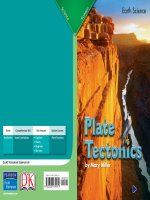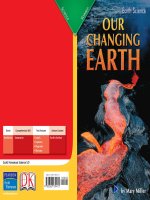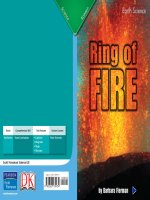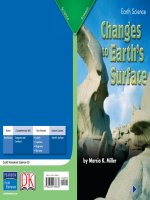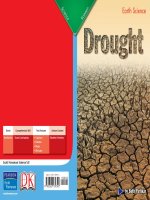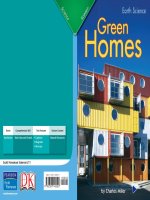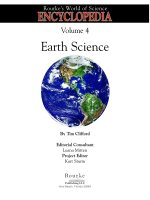4 9 ice (earth science)
Bạn đang xem bản rút gọn của tài liệu. Xem và tải ngay bản đầy đủ của tài liệu tại đây (2.97 MB, 10 trang )
Genre
Nonfiction
Comprehension Skill
Compare and
Contrast
Text Features
•
•
•
•
Labels
Call Outs
Maps
Glossary
Science Content
Earth’s Surface
Scott Foresman Science 4.9
ISBN 0-328-13885-1
ì<(sk$m)=bdi fc< +^-Ä-U-Ä-U
Vocabulary
Extended Vocabulary
deposition
earthquake
erosion
fault
landform
landslide
volcano
weathering
cryosphere
fjords
hexagonal
ice shelf
pellet
permafrost
topsoil
What did you learn?
1. What effect does melting ice have on
Earth’s surface?
2. What places on Earth are included in the
area known as the Arctic?
3. Where can glaciers be found?
4.
Icy weather
can take
by Anne
Cambal
many forms. Describe some of these forms.
Include details from the book to support
your answer.
5.
Picture Credits
Every effort has been made to secure permission and provide appropriate credit for photographic material.
The publisher deeply regrets any omission and pledges to correct errors called to its attention in subsequent editions.
Photo locators denoted as follows: Top (T), Center (C), Bottom (B), Left (L), Right (R), Background (Bkgd).
2 William W. Bacon III/Photo Researchers, Inc.; 7 Gavin Hellier/Alamy Images; 8 Norbert Wu/Minden Pictures;
10 Tui De Roy/Minden Pictures; 11 (T) Digital Stock; 12 (C) Per Breiehagen/Getty Images; 14 (TL) David Boag/Alamy Images.
Unless otherwise acknowledged, all photographs are the copyright © of Dorling Kindersley, a division of Pearson.
ISBN: 0-328-13885-1
Copyright © Pearson Education, Inc. All Rights Reserved. Printed in the United States of America.
This publication is protected by Copyright, and permission should be obtained from the publisher prior to any
prohibited reproduction, storage in a retrieval system, or transmission in any form by any means, electronic,
mechanical, photocopying, recording, or likewise. For information regarding permission(s), write to
Permissions Department, Scott Foresman, 1900 East Lake Avenue, Glenview, Illinois 60025.
3 4 5 6 7 8 9 10 V010 13 12 11 10 09 08 07 06 05
Compare and Contrast How are ice
shelves and icebergs similar? How are
they different?
What You Already Know
The outer layer of Earth is made of
rock. It is called the crust. The Earth’s
crust can have many different shapes. It
also has many landforms, such as plains,
valleys, and canyons. Landforms are
broken down into smaller pieces through
weathering. Physical weathering changes
only the size of rocks. In chemical
weathering, there is a change in the
material that makes up rocks.
Erosion is the process by which pieces
of Earth’s surface are moved from one
place to another. Erosion can be caused
by water, ice, gravity, and wind. Deposition
is when pieces of rocks are left in a new
place. This can happen slowly or quickly.
Erosion can be controlled. Plants grown
on hills help hold topsoil in place, which
stops erosion.
Gravity pulls loose material from
a high place to a low place. In a landslide,
many rocks and pieces of soil move
downhill quickly. An avalanche happens
when a great deal of snow and ice move
down a mountain quickly.
2
Far below the ground churns magma,
which is very hot rock that has partly
melted into a liquid. When gas forces the
magma upward, it breaks through the
Earth’s crust and erupts, forming a
volcano. Volcanoes that have erupted in
recorded history are active, while those
that have not are dormant.
The layer below Earth’s crust is the
upper mantle. The crust and upper mantle
are divided into plates. A fault is a crack
in rocks where Earth’s crust can move.
Rocks may get stuck at a fault, but the
plates continue to move. This puts
pressure on the rocks, forcing them to
break. The plates then move suddenly
and cause the crust to shake. This
shaking is an earthquake. Volcanoes
and earthquakes cause quick changes
to Earth’s surface.
Avalanche
Ice also changes Earth’s surface. It can
be found in many places and take many
shapes. Let’s look at the different shapes
ice can have.
3
Ice on Earth
North Pole
Two of the coldest places on
Earth are the North and South
Poles. The freezing, icy section
around the North Pole is called
the Arctic. This very large area
South Pole
includes the Arctic Ocean and
The two poles are at
parts of North America, Asia,
the top and bottom
and Europe. Greenland, the
of Earth.
world’s largest island, is also part
of the Arctic, as are many other islands. The South Pole is
in Antarctica, the coldest and windiest continent on Earth.
The Arctic and Antarctic regions are part of the
cryosphere. The cryosphere refers to the parts of Earth
where water is found year-round as ice or snow. This
includes areas with glaciers, sea ice, freshwater ice, and
frozen ground, which is called permafrost.
Ice is found as glaciers and ice caps at high altitudes
in mountain ranges. It’s found on or below the seas as
ice shelves or icebergs.
Due to its freezing conditions, the cryosphere
includes some of the most remote places on Earth.
Scientific research has been conducted in these regions
for many years, but it can be dangerous. Fortunately,
with satellite technology, scientists can electronically
measure and monitor conditions and changes in these
regions. They no longer must be exposed to potentially
dangerous weather.
Ice covers mountains in the
cryosphere all year long.
People can live in the Arctic, but it is very cold.
4
5
An Age of Ice
Approximately one million
years ago, glaciers covered
mountains on all of Earth’s
continents. At that time some
glaciers were several thousand
feet thick. This time is known
as the beginning of the
The white areas on this
Great Ice Age.
map show where ice once
Nearly one-third of the land covered Earth.
on Earth was covered by ice. The
ice caps of Greenland and Antarctica covered broader
areas and were thicker than they are today. Over time,
the ice melted and froze many times.
This process was repeated until about ten thousand
years ago, when rising temperatures caused much of the
ice on Earth to melt. As vast areas of ice disappeared,
so did some types of animals. The woolly mammoth and
the saber-toothed tiger
were well adapted to
the colder climates.
Both have been
extinct since the
end of the Ice Age.
Since the end of the Ice Age, the world’s climates
have warmed. This reduced the ice cover to what it is
today—about one-tenth of the land surface on Earth.
The warming made glaciers melt and ice sheets move.
These frozen masses carried rocks, sand, clay, and
minerals with them and deposited the materials in new
areas. Sometimes they formed hills. Other times they
flattened hills into plains. They also fractured
mountainsides, leaving rock so smooth that it looked
polished. They helped carve long, winding ocean inlets
called fjords (FYORDZ). A fjord is a narrow body of
deep water between steep slopes.
Fjords are typical of the
geography of Norway.
Woolly mammoth
6
7
Glaciers
Glaciers did not disappear completely when the
Ice Age ended. They are still common in the polar
regions of Earth. In this harsh climate, snow builds up
over time and turns to ice. From year to year, the ice
builds up and becomes a glacier. A glacier can contain
ice, snow, water, rocks, and other materials. A glacier
may have many cycles of melting and freezing,
yet still increase in overall size.
A huge mass of ice that covers millions of acres of
land is called an ice sheet. An ice sheet is a glacier that
occupies space on land. The thickness and weight of ice
sheets can be so great that the land under them sinks.
Antarctica’s ice sheet is nearly three miles thick! It
covers five million square miles of land. If all of its ice
gradually melted, Antarctica would slowly rise.
Gravity brought
this valley glacier
to its position
between these
mountains.
Glaciers are not just found at the poles. They can
be found in nearly every freezing area on Earth,
including the United States. Most U.S. glaciers are in
Alaska. The Bering Glacier is more than 125 miles, or
204 kilometers, long.
Valley glaciers start near the tops of mountains.
Gravity pulls them down the sides of the mountains,
leaving them in the U-shaped valley below. Valley
glaciers tend to be very long.
Antarctic ice sheet
8
9
Ice Shelves
Icebergs
Another body of ice found in the coldest regions
of Earth is an ice shelf. Ice shelves are thick sheets of
ice. They are extensions of ice sheets. Because they
consist of floating ice that’s still attached to land, ice
shelves help slow the melting of the glacier and its
movement due to gravity. When parts of ice shelves
break free from land, they become icebergs.
Icebergs are giant, floating
pieces of ice that have broken
Most of an iceberg
is below the surface
away from an ice shelf. Some
of the water.
icebergs may look white.
Older, denser ice often looks blue.
Icebergs are made of fresh water. A thin layer of dust
or salt water may be on the iceberg’s surface. But the
water in the middle of an iceberg is relatively pure.
Icebergs can change in size. Waves hitting an iceberg’s
sides can cause it to melt. Changes in temperature can
also cause melting. This melting may cause pieces of the
iceberg to break off.
The part of the iceberg that is visible above water
is only the tip. As much as nine-tenths of an iceberg is
under water, which makes icebergs dangerous for ships
passing near them.
This ice shelf
extends far into
the ocean.
Melting causes
the size of
an iceberg
to change.
10
11
Icy Weather
Icy weather is a feature of
many regions on Earth. Snow, sleet,
hail, freezing rain, and frost
all cause icy conditions. How do
these forms of ice differ? Why do
No two snowflakes
they occur?
are alike.
Snowflakes form when tiny
ice crystals in clouds stick to one another.
Snowflakes are hexagonal. These
six-sided wonders can be fancy or plain,
and each one is unique.
When rain falls through colder air near
the ground and freezes, it forms sleet.
Sleet looks and feels like small pellets of ice.
As pieces of ice fall and rise in a cloud, water
sticks to them and freezes. Strong winds may carry
the ice up and down many times. The layers of ice
form hail. When hailstones get heavy, they fall to
the ground. They can be as small as peas or larger
than golf balls.
When rain hits objects that are colder than 32ºF,
it freezes. This icy glaze is freezing rain. Freezing rain
can be dangerous and costly. Tree limbs may break
from the weight of the ice. Icicles form on houses.
When the ice on a house melts, it may seep into
cracks and cause leaks.
Icicles form in cold weather.
12
13
Frost can form on
trees and leaves
when it is cold.
14
Frost is often found on
cold mornings. Water from the
air can form on cooler objects
and freeze. These crystals of ice
can be so thick that they look
like snow.
There are three kinds of these
icy coatings. Hoarfrost is frozen
dew that creates a crystal-like,
white covering on whatever it
touches. Rime is a thicker coating
of ice that can take the shape of
spikes or feathers. Fern frost is
frozen dew that forms fernlike
patterns on glass.
Fun with Ice
Ice is more than just a product of
cold weather. You can use ice to cool
a warm drink. You can even make art
from a piece of ice! In icy or snowy
weather, you can go ice skating, skiing,
and sledding.
Ice is one of Earth’s features. It can
be as huge in scale and wonder as the
glaciers at the poles or as small as frost
on a cold morning. Either way, ice is an
important part of life on Earth.
This swan sculpture
is made of ice.
15
Vocabulary
Glossary
Extended Vocabulary
What did you learn?
deposition
earthquake
erosion
cryosphere
fault
landform
landslide
volcano
fjords
weathering
cryosphere
fjords
hexagonal
the part
of Earth’s surface
ice
shelf
where ice and snow are found
pellet
year-round
permafrost
long,topsoil
narrow bodies of water
between steep slopes
3. Where can glaciers be found?
hexagonal
having six sides
4.
ice shelf
a thick, permanent sheet of ice
that is attached to land
Icy weather can take
many forms. Describe some of these forms.
Include details from the book to support
your answer.
pellet
a little ball
5.
permafrost
a layer of permanently
frozen soil
Compare and Contrast How are ice
shelves and icebergs similar? How are
they different?
Picture Credits
Every effort has been made to secure permission and provide appropriate credit for photographic material.
The publisher deeply regrets any omission and pledges to correct errors called to its attention in subsequent editions.
topsoil
the upper part of the soil
Photo locators denoted as follows: Top (T), Center (C), Bottom (B), Left (L), Right (R), Background (Bkgd).
2 William W. Bacon III/Photo Researchers, Inc.; 7 Gavin Hellier/Alamy Images; 8 Norbert Wu/Minden Pictures;
10 Tui De Roy/Minden Pictures; 11 (T) Digital Stock; 12 (C) Per Breiehagen/Getty Images; 14 (TL) David Boag/Alamy Images.
Unless otherwise acknowledged, all photographs are the copyright © of Dorling Kindersley, a division of Pearson.
ISBN: 0-328-13885-1
Copyright © Pearson Education, Inc. All Rights Reserved. Printed in the United States of America.
This publication is protected by Copyright, and permission should be obtained from the publisher prior to any
prohibited reproduction, storage in a retrieval system, or transmission in any form by any means, electronic,
mechanical, photocopying, recording, or likewise. For information regarding permission(s), write to
Permissions Department, Scott Foresman, 1900 East Lake Avenue, Glenview, Illinois 60025.
16
3 4 5 6 7 8 9 10 V010 13 12 11 10 09 08 07 06 05
1. What effect does melting ice have on
Earth’s surface?
2. What places on Earth are included in the
area known as the Arctic?

